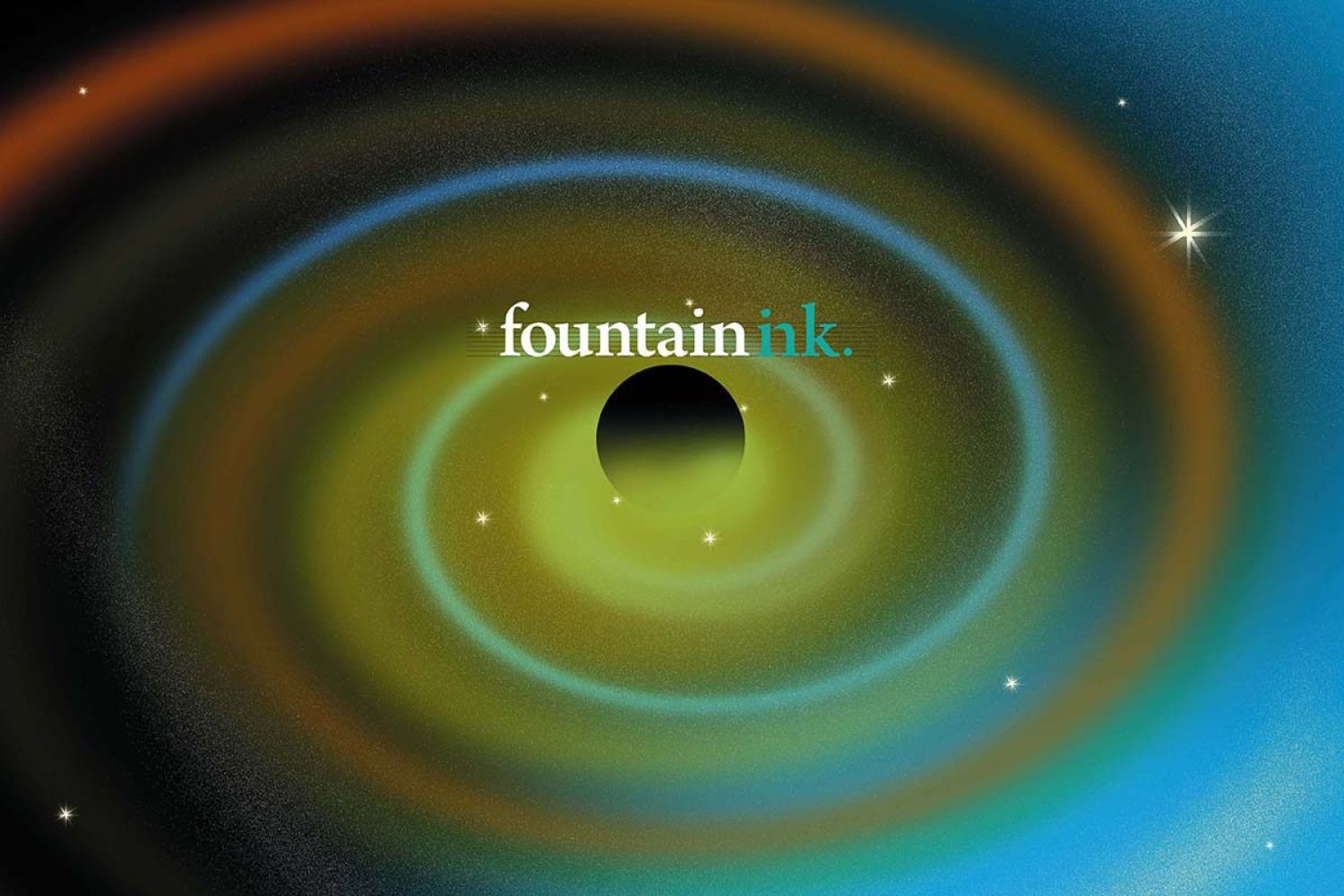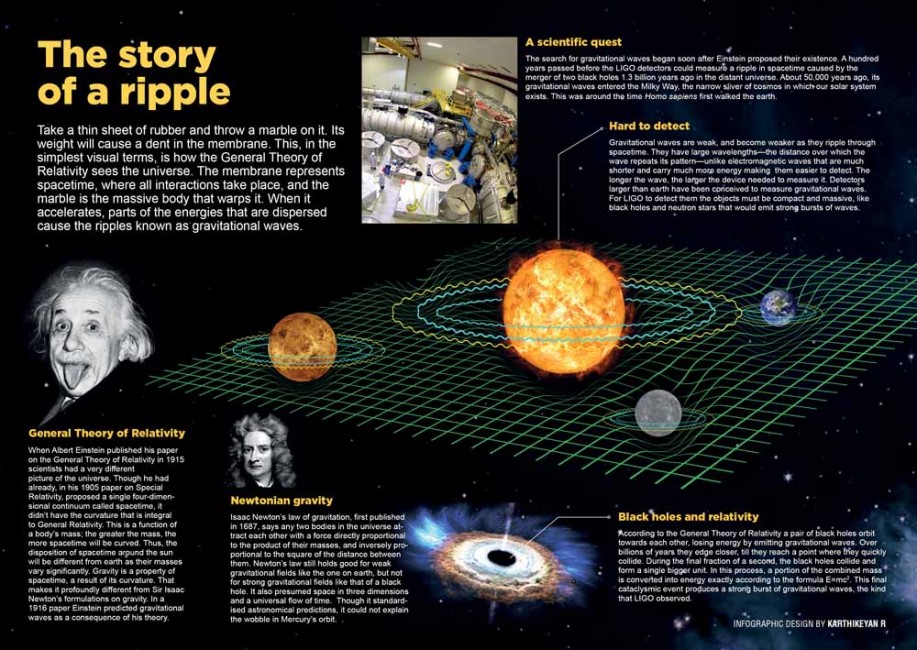
On September 14, 2015,
Marco Drago, a 33-year-old Italian post-doctoral researcher and writer of
fantasy novels, was in his office at the Albert Einstein Institute in Hanover,
Germany, talking to a colleague over Skype. Drago was one of more than a thousand
scientists working in an international collaboration called the Laser
Interferometer Gravitational-Wave Observatory (LIGO) to detect the unimaginably
tiny ripples in the spacetime fabric predicted by Albert Einstein 99 years ago.
At the heart of the collaboration’s efforts are two enormous detectors in the
states of Washington and Louisiana in the United States, sensitive enough to
detect vibrations a thousand times smaller than the diameter of a proton. As
Drago checked his email, he noticed that among the several dozen mails he
receives from LIGO every day, was an alert that the detectors had picked up
something significant. It would be some time before Drago realised the true
significance of the small squiggle he saw on his computer screen.
He was the first human to see what a real gravitational wave looks like.
He was the first human to see what a real gravitational wave looks like.
A few minutes earlier, just before 11 a.m. Central European Time, laser beams travelling more than a hundred kilometres in a huge vacuum tunnel inside the LIGO detectors picked up a signal originating from two large black holes that crashed into each other with explosive force more than a billion years ago, sending convulsions through spacetime at the speed of light. This rare cosmological event, known as a binary black hole-coalescence, had been theoretically predicted by physicists, but no one had proof they happened. The black holes, which had been circling each other peacefully for millions of years, drew closer and closer to each other by their combined gravitational force, moving faster and faster and radiating more and more energy as they spiralled around each other at speeds close to that of light, till in a fraction of a second, they merged to form a single entity. The dying flash of gravitational energy that escaped the event in the last one-fifth of a second travelled a distance more than 10,000 times the diameter of the Milky Way to pass through the twin detectors in USA. The detection would later be officially named GW15094.
At the time Drago noticed the detection, Arunava Mukherjee, a post-doctoral researcher from the International Centre for Theoretical Sciences (ICTS) in Bengaluru was working just across the corridor, in his temporary office at the Einstein Institute. Arunava is part of the eight-member LIGO team in ICTS, and was visiting Hanover to work on a project at the institute. He was in the company of Professor Parameswaran Ajith, who led the ICTS team.
“No one believed Drago when he said there was a signal,” Arunava says. “We thought it was a prank. Or that it was an instrumental artifact. When he joined us for lunch all of us thought the same.” There was a particular reason that Arunava, and later, when they got to know of the detection, his colleagues in Bengaluru, had doubts about whether the signal was genuine. LIGO does blind injections of fake data, to keep scientists on their toes. Only a handful of LIGO leaders know when such injections are made.
The next morning, members of the LIGO group received a mail from the director of the institute, asking them to report for an emergency meeting. Arunava realised immediately that something was up.
“When I entered the director’s office, he asked me if I was a member of the group. He checked everyone, and then locked the door. He asked people to close all the windows in the room. He then announced that the signal was genuine, there had been no blind injection.”
After an hour-long discussion, where the director fielded questions and swore the LIGO members to secrecy, most people still could not believe it. “It was 50:50. You could never be sure.”
Ajith was not in Hanover when Drago saw the detection. He had left for India two days earlier, and planned a short vacation in the backwaters of Kerala before getting back to the grind in Bengaluru. An alumnus of the Albert Einstein Institute, he got his doctorate in gravitational waves in 2007, and then a post-doctorate. While there he collaborated on a paper that came up with a new method, called the phenomenological method, which describes the gravity waves emerging from black-hole mergers like GW150914.
Just before he graduated in 2007, Ajith made a bet with three of his fellow students in the institute. The advanced LIGO detectors would lock on to a gravitational wave signal by 2015. But that was assuming that they would be up by schedule, and with the schedule changing, Ajith did not expect LIGO to see gravitational waves till 2018.
He won his bet with just three months to spare.
The first person to
learn of the “trigger” back home at ICTS was Archisman Ghosh, a postdoctoral
researcher working with Ajith. The event happened at 3:21 p.m. Indian time. In
three minutes, an automated computer program had scoured the data to find
signatures of expected gravitational wave sources, taking apart the mixture of
noise and the astrophysical signal.
Unlike Drago, who was part of the data analysis sub-group in LIGO, Archisman had not subscribed to automatic alerts for triggers from the detectors. He was the only one in the office at that time and after a while he went home and then for a workout before returning to ICTS. Around 7 p.m. he checked his email. There was a message that said a trigger of unusual signal strength had been caught by LIGO detectors.
“The signal was too good to be true. Besides, the detectors were going through an engineering run and had begun data collection only a short time back. It looked just like if it had been a blind injection to get everyone going,” he says. But like other groups in the US, Germany, UK and other countries, the ICTS team too started work on the data assuming it to be real. Archisman called up Abhirup Ghosh, a doctoral student in the LIGO team and told him about the trigger.
Ever since the start of the LIGO project in 1995, several astronomical sources were considered candidates for gravitational waves. The stronger the energy of the waves the greater the chances that they would come within the frequency range of LIGO detectors. They were searching specifically for the intense gravitational waves from end-of-life binary systems where two objects merge into one. The general expectation was that the first gravitational wave detection would come from a pair of neutron stars spiralling into each other.
Neutrons stars are composed almost entirely of neutrons and are the densest and smallest stars in the universe. They are small enough in size to be compared to cities, but so dense that a teaspoon of material can weigh more than five billion tonnes. Coalescing binary black holes like GW15094 were considered less likely as physicists had little idea how often such events happen.

The pattern of gravitational waves varies according to the source that emits it. Archisman didn’t need to run any computations to see the signal had the signature of a binary black hole collision. This was a stroke of luck for the ICTS team. For several months, Abhirup and Archsiman had been working on binary black hole mergers as a possible source of gravitational waves. Ajith had worked extensively on black hole mergers over the years. Under his guidance, they had just finished developing a way to test how consistently Einstein’s theory describes the process of black holes colliding and merging. This was too good an opportunity to miss.
“At 11.41 p.m. I received a mail from Walter del Pozzo, who was collaborating with us from the University of Birmingham, asking me whether we could run our consistency tests on the data. Even if it was a blind injection we would get a chance to see if our tests worked. Just before midnight I called Ajith to tell him. He asked us to start at once. We decided to start working on the data from Tuesday morning (September 15). That was the most hectic week in my life,” Archisman says.
Ajith gets up and walks to the green chalk board and draws a series of wiggles—the wave form of GW15094. As he draws, he explains that the pattern is that of a “golden binary”. “This is the ideal signal we could expect. Later, the LIGO spokesperson sent a mail to everyone saying that this was a genuine detection not a blind injection. But I did not believe it till two weeks after the event. You see, I thought it could be a double blind.”
The waves start with smooth troughs and crests, very evenly spaced. This part corresponds to the inspiral phase, where the black holes are orbiting each other in ever smaller orbits. In the middle, the frequency suddenly spikes, with a number of sharp crests and deep troughs. This is the phase where they collide and merge. The last, where the waves start getting flatter, is the ring-down phase, where a new black hole 62 times the mass of the sun settles into a stable state.
Till relatively recently, physicists did not have the ability even to theoretically model such waves in a precise and complete way. The development of complete theoretical models of gravitational waves from high mass, high energy cosmic events allowed LIGO scientists to theoretically compute the rough data that emerged from the signal. There are two ways to do this.
“One is called the effective one-body method which does this in a theoretically rigorous way. The second, phenomenological method, does it in a simpler way,” says Ajith.
He has made crucial contributions in developing the phenomenological method along with several collaborators. Professor Bala Iyer, his one-time mentor, now his colleague at ICTS, had worked with a group of French scientists in developing analytical solutions to Einstein’s equations that made both the methods possible.
Growing up in Malappuram in north Kerala, Ajith dreamt of studying at FTII in Pune and becoming a film maker. He says he was an indifferent BSc student, getting just enough marks to make it to an MSc in Mahatma Gandhi University, Kottayam. There he met two wonderful teachers who changed his future. A husband-wife pair, their classes in quantum mechanics, relativity theory and astrophysics captivated him. They advised him to do a project under Sanjeev Dhurandhar, one of the pioneers of gravitational wave physics in India, then at IUUCA in Pune.
Sanjeev Dhurandhar was
one of a small group of physicists along with Bala Iyer fighting a lonely
battle to establish the field of gravitational wave physics in India. Many of
the Indian scientists leading the research in LIGO are students trained by
Dhurandhar and Iyer. Ajith next did a project under Iyer at the Raman Research
Institute, a period that resulted in his first published paper. His work led to
the offer of a doctorate position at the Max Planck Institute for Gravitational
Physics in Germany, also called the Albert Einstein Institute.
When Ajith arrived in Germany in 2004, it was an exciting time for gravitational wave physics. The LIGO detectors had started working and a similar detector called Virgo was also operational in Italy. Physicists who chose the field as their speciality, worked with the assumption that gravitational waves would be found in the near future, opening up exciting new vistas and giving birth to gravitational wave astronomy.
This was not the case even ten years ago, and when Iyer and Dhurandhar started their work in the Eighties, gravitational wave detection was a remote possibility in the future, perhaps never to be realised in their lifetimes. Doubt about whether these exotic waves could be found, or whether they even exist, had been there since Einstein predicted them in 1916. Einstein himself was to change his mind on whether they existed, and change it back again. In his 1916 paper he wrote that they were too weak to be ever detected.
The doubts about their existence subsided in 1974 when Taylor and Hulse obtained indirect evidence of gravitational radiation by observing a pulsar rotating around a companion star. They received the 1993 Nobel Prize for the discovery of the binary pulsar. Still, very few physicists believed it was a worthwhile hunt. For one, the cost of building a facility like LIGO was astronomical. There were great engineering and technological challenges which many feared would turn the whole thing into a wild goose chase.
Two men who played a leading role in conceiving LIGO and convincing the US government that it was worthwhile to build the detector are Reiner Weiss and Kip Thorne. Thorne is known in popular media for two things—for coming up with the theory of time travel through wormholes and for his work on the film Interstellar as scientific adviser and script writer.
After leaving the Einstein Institute, Ajith would work on gravitational waves at the California Institute of Technology, as a member of both the LIGO lab and Thorne’s relativity research group. When he returned to India in 2013, he joined the newly established ICTS as a faculty member.
The Max Planck Society, which runs the Max Planck Institutes, is the historical successor of the Kaiser Wilhelm Institute, where Einstein worked when he discovered his General Theory of Relativity in 1915. In 1913 the great physicist Max Planck travelled to Switzerland, where Einstein was working, to win him over for German science. Einstein accepted the offer of a professorship at the yet to be founded Kaiser Wilhelm Institute, which had the great attraction that it carried no teaching responsibilities and left Einstein free to do as he wished. Einstein’s first results on relativity in 1905 came to be known as the Special Theory of Relativity. It revolutionised the concept of time and space and changed everything we knew about the universe.
Suppose, when Planck was travelling to Zurich to meet Einstein, he had carried a torch along with him in the train. And further suppose that Einstein was waiting at the station to receive him. Just as the train draws into the station, Planck switches on the torch and a light beam travels from his end of the coach towards a mirror on the wall of the side opposite. Just as the light hits the mirror, he starts his stopwatch. The light beam is reflected back and hits another mirror on the wall on Planck’s side of the coach. Planck stops his stopwatch at the precise moment that the light beam reaches the second mirror. By measuring the distance between the two mirrors and performing a simple division, Planck is able to get the speed of the light beam.
If Einstein also carried a stop watch, he would be able to measure the time that it takes the light beam to travel from the first mirror to the second. But for Einstein who is on the stationary platform, the distance travelled by the light beam is greater than for Planck, who is inside the moving train. So, by Newton’s laws of motion (and common sense), the speed of the light beam is different for Einstein and Planck. But strangely this is not the case. The speed of light is the same for all observers, whatever their own respective speeds.
The solution Einstein came up with in 1905 was that time depended on the speed at which an observer is moving. Einstein’s calculations also showed why no one had noticed such a peculiar thing before. The closer a body moves to the velocity of light, the greater this effect.
This was the biggest
scandal in physics at the end of the 19th century and no physicist could
provide a satisfactory answer. The solution Einstein came up with in 1905 was
that time depended on the speed at which an observer is moving. Einstein’s
calculations also showed why no one had noticed such a peculiar thing before.
The closer a body moves to the velocity of light, the greater this effect. The
fastest hypersonic jets only achieve speeds of 11,000 km per hour, while light
moves at almost 300,000 km per second.
The effect is negligible at these low speeds. But if one were to travel eight years in a future space ship that could move at the speed at which the black holes collided with each other (around 60 per cent of light speed), one would find on returning that 10 years had passed on earth in the meantime.
Relativity overturned all our intuitive concepts of space and time. Not only does the duration of events vary according to how fast an observer is moving, but the absolute space and time of Newton’s physics had to be abandoned. Instead, the three dimensions of space and one of time are now understood to be four dimensions of a single entity, the spacetime continuum. This was the picture in 1905. Einstein’s theory was controversial at first, and Max Planck, the first major physicist to recognise its value, promoted it in the scientific community.
Even as his ideas were being debated and discussed, Einstein occupied himself with what would come to be regarded as his greatest scientific achievement. As physicists discarded Newton’s laws of motion, his gravitational theory also lost its applicability. Einstein spent the next 10 years developing the theory that would explain gravity and cause a revolution even greater than the one he caused with his Special Theory of Relativity. His General Theory of Relativity explains gravity not as a force that operates between bodies, but as movement caused by the curvature of spacetime.
We can think of objects being curved, but it is impossible for us to visualise space itself as curved. One way to do this is to imagine spacetime as an extraordinarily large sphere. We experience the surface of the earth as flat, though it is in reality curved. The shortest distance between the places that we travel to is not really a straight line but a curve. In similar fashion, as three-dimensional creatures we do not experience spacetime as curved, but as flat.
The General Theory of Relativity says that the mass of objects curves the space around it. The greater the mass, the more the curvature. A common example used to illustrate the phenomenon is of a ball on a trampoline. If the ball is massive, it creates a dent in the trampoline, by stretching its fabric. Massive objects similarly create dents in spacetime. Mass tells spacetime how to curve, and spacetime tells mass how to move, as it were.
Instead of fabric, if we imagine spacetime as a pond and objects as bodies that float in it, we are able to get a visualisation for gravitational waves. The floating objects cause dents in the surface of the water as they float, but if they move faster, they send out ripples along the pond. Bodies that accelerate in space-time radiate gravitational waves. When they pass through a region of spacetime, time dilates or speeds up for the objects in it. Their relative positions also change.
Einstein’s equations
describe the way all the objects we see move, from a small pebble to cars to
massive planets, stars and black holes. But the equations turned out to be so
complex mathematically that physicists found it impossible to get perfect
solutions for them. So they work around it, by using methods of approximation
that allows them to calculate the solutions to a defined degree of accuracy.
From the Eighties, when the first phase of serious research into gravity waves
started around the globe, Bala Iyer was working at developing such theoretical
descriptions of gravitational waveforms, together with a group of French
gravitational physicists. The wave forms they developed using the pen and paper
method, made it possible to calculate gravitational waves associated with any
mass or velocity. That is, up to a point. As the mass and velocities got very
large and gravitational fields very strong these models broke down. But the
increasing processing power of supercomputers and the development of certain
mathematical tools changed the picture. In 1990, two physicists developed a
simulation of gravitational waves radiating from the formation of a black hole.
In 1995, a partial simulation of binary back holes colliding was achieved. By
2005, precise simulations of the inspiral and merger phases of binary black
hole became available.
But simulations are extremely costly and only a relatively limited number of them can be computed. Physicists can simulate black hole mergers at various intervals of mass and velocity, however large or fast. But no picture can be formed of gravity waves from black holes, which fall between these sample intervals. This was a serious problem for detecting wave forms to detect real gravitational waves, whose values and exact form are unknown beforehand.
Pen and paper analytical methods could, on the other hand, predict gravity waves from objects of any mass and velocity, but only if the values did not cross a threshold. The solution was developing ways of combining the two methods into a hybrid method, which is used to model wave forms for the entire possible spectrum of binary black hole, and binary neutron star mergers.
The phenomenological method, developed first by Ajith and his colleagues in 2007, achieved this using a simple, easy-to-compute method. More advanced versions of the phenomenological method were evolved by physicists who built on Ajith’s work. It was one of the two key techniques that allowed LIGO scientists to model theoretical wave templates, using which the data of GW150914 were analysed.
Once the initial rough data came in through the detection pipelines, various research sub-groups within LIGO started to work on different aspects of the data. Multiple sub-groups worked on the same set of data, sharing their results with each other and refining them. The results are eventually shared with the entire collaboration, so other groups can utilise it.
Given that the claim of observing gravitational waves was an extraordinary one, LIGO had to make sure that the evidence to back that claim was extraordinary. The confidence in observation had to pass 5 sigma, the gold standard in physics to announce something as having been observed. At 5 sigma, the possiblity that the results of an observation is because of chance, is statistically equivalent to around one in 3.5 million. LIGO’s results were at 5.1 sigma, which means there is only one chance in 5 million that the results are a fluke.
To ensure that a premature announcement was not made the LIGO team was sworn to complete secrecy, so that none of their colleagues outside the collaboration knew about it. All the detector equipment was checked to eliminate any mechanical errors, and the code of the algorithms in the detection pipeline was rechecked line by line. From September 14 to February 11, when the announcement was made to the world, LIGO scientists rechecked the data multiple times, while also extracting astrophysical information about the different stages of the black hole merger and features of the gravitational waves.
Abhirup Ghosh (left) and Archisman Ghosh are two of the 37 Indian scientists credited for the detection of gravitational waves.
The test of general relativity that the ICTS group was working on evolved from Abhirup Ghosh’s summer project with Ajith. The ICTS was set up in 2012 by the Tata Institute of Fundamental Research. In a short period, ICTS has gathered a small team of highly qualified faculty members who would work in core areas of theoretical physics and pursue interdisciplinary research.
Abhirup, who did his MSc in physics from IIT Roorkee joined ICTS because he thought the institute offered greater flexibility in research, which turned out to be true. When he approached Ajith to mentor his summer project, Ajith asked him to take forward an idea he had developed theoretically while at Caltech, but whose implementation had not been fully worked out. This was to test the consistency of Einstein’s equations of general relativity in black hole binary mergers. As Abhirup worked on the project, it evolved, and when he joined LIGO, it became his thesis project.
Eintein’s equations have been tested in all kinds of astronomical events and held consistent. But the gravitational fields of ordinary astrophysical bodies, including huge stars are weak. The theory has not been tested enough in strong gravitational fields, which occur only in supernovae or when stars implode to form neutron stars and black holes. The gravitational field of black holes are so strong that not even light can escape it.
While no one believes that relativistic gravity is wrong, it is possible Einstein’s equations might require modifications in very strong gravitational fields. Some physicists believe that general relativity will eventually have to be modified, to unite it with quantum mechanics, the theory governing the sub-atomic realm. Archisman and two other ICTS colleagues, Nathan Johnson-McDaniel and Chandra Kant Mishra, helped Abhirup in developing the theoretical architecture of the IMR (Inspiral Merger Ring-down) consistency test. The test calculated the final mass of the black hole from two parts of the observed signals—the part produced by the inspiral before they merged, and the part produced by the merger and subsequent ring-down of the final black hole.
If these two estimates are inconsistent with each other, it would mean that the dynamics given by Einstein’s equations are not consistent with the way binary black holes in the universe spiral into each other to form a new entity.
On September 15, a
Tuesday, Abhirup and Archisman are in their office by 11 a.m., geared up for
work. Before the detection event Monday, they had been putting the finishing
touches to the code in the IMR test. To apply it, they needed the initial
masses and spins of the black holes. For this, they run a parameter estimation
pipeline on the data, a set of algorithms developed by LIGO which computes
fundamental parameters of the black holes from the gravitational wave data.
By afternoon, they have the results. Abhirup now works on implementing the IMR consistency test. Archisman is part of the parameter estimation sub-group of LIGO, whose members work on deriving further parameters from the primary ones and sharing it as fast as possible with the LIGO group, so that different projects can use the information for their calculations. Abhirup uses part of the IMR code they have developed, to obtain the final mass and spin of the single black hole formed from the merger. By 2:25 p.m., Abhirup obtains the first crude results. It shows the team that their test can be applied to the data. That it works. It also indicates that there is no deviation between Einstein’s predictions and the black hole merger that caused GW150914. But they need to further refine the tests.
In the evening, Ajith, who has returned to Bengaluru, joins them. He is excited that the team has picked up on the data so fast. For further refining the IMR test, they use a supercomputer they have named “dogmatix”, after the famous pooch in Asterix comics. By 8 p.m., Abhirup has estimates of the final mass and spin. He puts it up on a website that other LIGO members can access. The next day, the more reliable results of the general relativity confirmation tests are obtained and Abhirup puts it up on the website. At 9:35 p.m. Saturday, Ajith puts up the final results of the consistency tests and advertises the results to the entire collaboration. No deviation has been found with general relativity. By this time, the team has started working nights. At four in the morning on Sunday, Archisman, is able to put up final results for various other parameters like the mass spin and volume of the black hole. Soon, other groups start contacting the ICTS team with questions about the results. They take questions in teleconferences of various, sub-groups, defending, explaining and refining their results.
On Monday, a week after the detection event, the results are uploaded on the official LIGO wiki. On Wednesday, the IMR results get some serious attention and it seems that it will be published along with the detection papers. At the end of September, the team is reasonably sure that the consistency results are solid.
Frenetic weeks of reviews by LIGO members not involved in calculating these results follow. There is a review conference every week till January, as the results get more and more firmed up. Every line of code is taken apart by the reviewers to be checked. As the announcement date in February approaches, there are on average two review teleconferences every week. Both Archisman and Nathan had not completed a year in the LIGO collaboration. By LIGO rules, only those who have been members for a year, get authorship when the results are published. But given the momentous nature of the breakthrough, LIGO announced a process by which members who do not qualify under the one-year rule were allowed to petition for inclusion, if their contributions were significant. Nathan and Abhirup petitioned for authorship in the detection paper based on their contributions to the IMR consistency test and a few other contributions Their petition was accepted. The test found a place in the detection paper. It was also part of the complimentary paper on tests of general relativity, along with four other tests from around the world, all of which declared the rigorous conformity of Eintein’s equations of general relativity with the evolution of in-spiraling binary back hole mergers. After the announcement of LIGO’s detection of gravitational waves to the world, the ICTS team members have more time on their hands. The excitement and exhilaration of the first two weeks, had slowly dissipated over the gruelling months that followed. Now it comes back at times, in waves that suddenly rise up and recede.
“This is too early in my career. I am still getting used to that,” says a bemused Abhirup. Archisman and Abhirup talk exuberantly of gravitational wave astronomy, a field birthed the moment the waves passed through the detectors at Louisiana and Washington. A moment that depends on what spacetime region you are in. “We have radio wave, X-ray, gamma ray astronomy. But if you think about it, they are all electromagnetic radiations of different frequencies. Now we have another way of detecting objects in space and measuring cosmological parameters.”
Ajith has dug out the paper he and his three friends in the Albert Einstein Institute had signed to seal their bet. With the distance of time, it looks both interesting and amusing to him. It reads:
“The SNR > 8 Conjecture
Conjecture: The instruments of the LSC will detect at least one gravitational wave with signal-to-nose ratio greater than 8 before the last hour of 2015.
We Daniel Friedrich, Ajith Parameswaran, Kentaro Somiya, and Kazuhiro Yamamoto, place a positive bet on the conjecture.
I Jan Harms, place a negative bet on the conjecture.
Whoever will lose the bet, will have to invite the other betting party for dinner and pay for travel expenses.
Hannover, 22nd of November 2007”
The friends had all scrawled their signatures below. A few months before the document was signed, Ajith had completed work on the research paper on the phenomenological method for finding the waveforms of binary coalescing black holes. A gravitational wave from a coalescing binary black hole would be detected by the instruments of LSC 108 days before the last day of 2015. An algorithm would comb through the noise for the signal and send the information to Marco Drago in Hanover, winning the bet for Ajith’s betting party at the very place where the bet was made. The signal-to-noise ratio was 24.





